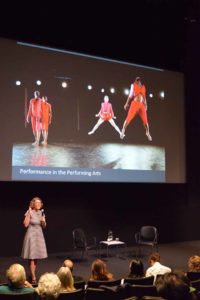Performance everywhere
Laura Belik on the Arts + Design Wednesdays @ BAMPFA | Curation Across Disciplines talk
Curating the Performing Arts in the Age of Performance with Shannon Jackson (Arts + Design, TDPS, Rhetoric), response by Rob Bailis (Cal Performances)
“Performance is happening everywhere today”, began Shannon Jackson, Associate Vice Chancellor for Arts + Design, UC Berkeley. Even though many would connect this term with theater, music or dance, it is easy to recognize how it can be related to several different practices and disciplines. From the practices of every-day-life, to speech and protests, we are constantly encountering examples of what performance means in our contemporary settings.
 Interestingly enough, the term “performance” is actually relatively new to the Theater and Dance fields. What at first was called “produce”, or “present”, today is known as perform. Performance is a mode, a medium, a term- a deployment of the body in space and time. This open understanding of what the act of “perform” can be brings together a range of associations beyond the artistic fields, such as political interpretations, rituals, protests, and so on.
Interestingly enough, the term “performance” is actually relatively new to the Theater and Dance fields. What at first was called “produce”, or “present”, today is known as perform. Performance is a mode, a medium, a term- a deployment of the body in space and time. This open understanding of what the act of “perform” can be brings together a range of associations beyond the artistic fields, such as political interpretations, rituals, protests, and so on.
But if performance is everywhere, what is the role of the curator of performing arts today? In order to answer this question, Shannon Jackson invited Rob Bailis, Associate Director at Cal Performances to join in the conversation. To start this discussion, one important observation is made: The performance metaphor is very ubiquitous, and so is curation.
This relationship between the arts of “perform” and “curate” call the attention to today’s relationship between Theaters and Galleries, and the idea of the medium where the performances are organized. The modernist gallery space, originally the white cube, has started to be challenged through innumerous projects that raise the question of “what the gallery space can be as a space of encounter?” Jackson also compares and contrasts both spaces of the theater and the gallery over their relationship with the audience. While gallery beholders are moving through the gallery space in order to see the artworks that stays in place; the theater audiences in the traditional performing art spaces stay static during the presenters acts. The “black box and the white cube” are starting to intermingle and to reinvent their uses.
From this perspective, the idea of the medium comes together with the discussion of curating performance across disciplines. The post-modern performance stage is no longer the traditional theater space necessarily. And the performance act is no longer the traditional play or dance. Wider performance forms (traversing disciplines) comes along with new ideas of what the performance stage can be: the street, the body, the gallery, the speech, the plaza, the internet… And the role of the audience gains a different perspective as well, as many times part of the project is related to ideals behind community gathering. Consequently, post-modernist performances require post-modernist approaches to curation as well.
Lauren Belik (PhD Student, Architecture) reviewed the September 27, 2017 talk, Curating the Performing Arts in the Age of Performance with Shannon Jackson , as part of the Fall 2017Arts + Design Wednesdays @ BAMPFA series. To learn more about the series, see below:
What does it mean to curate? How has the role of the curator changed in our contemporary moment? Does the curator function differently in the performing arts, the visual arts, film, and in the fields of science and technology? And, how has curating changed as it responds to new forms of cultural and digital participation? When curation has become a popular metaphor in many domains –from food, to music, to social media — how do we define this expanded practice?
Co-taught by Shannon Jackson, Associate Vice Chancellor of the Arts + Design; Natasha Boas, independent curator, art historian and critic; and Eric Siegel, Director of the University of California Botanical Garden at Berkley, Arts + Design Wednesdays @ BAMPFA will explore this theme with some of the most innovative and incisive writers, artists and scholars of our time. Learn more here.
